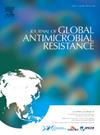Systematic review and meta-analysis on antimicrobial resistance and drug resistance in Saudi Arabia
IF 3.7
3区 医学
Q2 INFECTIOUS DISEASES
引用次数: 0
Abstract
Background
Antimicrobial resistance (AMR) and drug resistance have emerged as major global health concerns, threatening the effectiveness of antimicrobial agents and compromising patient outcomes [21]. The rapid spread of resistant pathogens poses significant challenges to healthcare systems worldwide, leading to increased morbidity, mortality, and healthcare costs [20].
Methods
Search Strategy
To find pertinent studies released up until September 2023, a thorough search was done in electronic databases like PubMed, Embase, and Scopus. The search method combined terms linked to Saudi Arabia, drug resistance, and antimicrobial resistance (AMR). The specific search terms and Boolean operators used were tailored to the requirements and functionalities of each database.
Results
The systematic review includes 25 papers in total, representing various Saudi Arabian healthcare environments and patient groups. The prevalence of AMR varied across different pathogens and antimicrobial agents. The most resistant Enterobacteriaceae were carbapenem-resistant Enterobacteriaceae (CRE), extended-spectrum -lactamase-producing Enterobacteriaceae (ESBL), and methicillin-resistant Staphylococcus aureus (MRSA). The full manuscript will report the pooled prevalence rates and 95% CIs for each resistance type. The rates for such bacteria were 38.7%, 26.4%, and 15.2% respectively suggesting an imminent need for improvement in surveillance measures & interventions to reduce the burden of AMR (Antimicrobial Resistance).
Conclusion
The prevalence of antibiotic resistance (AMR) is alarmingly high in Saudi Arabia. The aim of this study was to examine the prevalence of AMR across different types of pathogens and antimicrobial agents. A meta-analysis was conducted to quantify the pooled prevalence of each type of resistance across hospitals, environments, and food samples from Saudi Arabian locations. The study identified three types of resistance: carbapenem-resistant Enterobacteriaceae (CRE), extended-spectrum -lactamaseproducing Enterobacilli (ESBL), and methicillin-resistant Staphylococcus aureus (MRSA). Furthermore, the study identified several risk factors associated with AMR, including prior antibiotic use, healthcare-associated infections, and prolonged hospital stays.
关于沙特阿拉伯抗菌药耐药性和抗药性的系统回顾和元分析。
这项对 25 项研究进行的荟萃分析表明,抗菌药耐药性(AMR)是沙特阿拉伯的一个严重问题。研究显示,MRSA、产生 ESBLs 的肠杆菌科细菌、耐碳青霉烯类的肠杆菌科细菌、铜绿假单胞菌和鲍曼不动杆菌的耐药性水平较高。这些细菌的耐药率分别为 38.7%、26.4% 和 15.2%,这表明迫切需要改进监控措施和干预措施,以减轻 AMR(抗菌药耐药性)的负担。在这方面,必须同时实施有效的感染控制计划和有针对性的全球政策,同时促进抗生素管理,以有效保护抗生素的疗效。此外,相关风险因素(包括之前使用抗生素药物、长期住院以及与医疗保健相关的感染)也增加了检出率,进一步凸显了这一迫切需要有关部门立即关注的问题。通过使用适当的统计程序收集的研究数据绘制了森林图,并显示了置信区间(CIs)。结论表明,实施更好的政策/控制建议,重点关注可实现的目标,可以提出旨在减少 AMR 的对策,确保及时进行适当的治疗,避免耐药微生物带来的潜在风险,同时适当保护抗生素的现有生命力。
本文章由计算机程序翻译,如有差异,请以英文原文为准。
求助全文
约1分钟内获得全文
求助全文
来源期刊

Journal of global antimicrobial resistance
INFECTIOUS DISEASES-PHARMACOLOGY & PHARMACY
CiteScore
8.70
自引率
2.20%
发文量
285
审稿时长
34 weeks
期刊介绍:
The Journal of Global Antimicrobial Resistance (JGAR) is a quarterly online journal run by an international Editorial Board that focuses on the global spread of antibiotic-resistant microbes.
JGAR is a dedicated journal for all professionals working in research, health care, the environment and animal infection control, aiming to track the resistance threat worldwide and provides a single voice devoted to antimicrobial resistance (AMR).
Featuring peer-reviewed and up to date research articles, reviews, short notes and hot topics JGAR covers the key topics related to antibacterial, antiviral, antifungal and antiparasitic resistance.
 求助内容:
求助内容: 应助结果提醒方式:
应助结果提醒方式:


